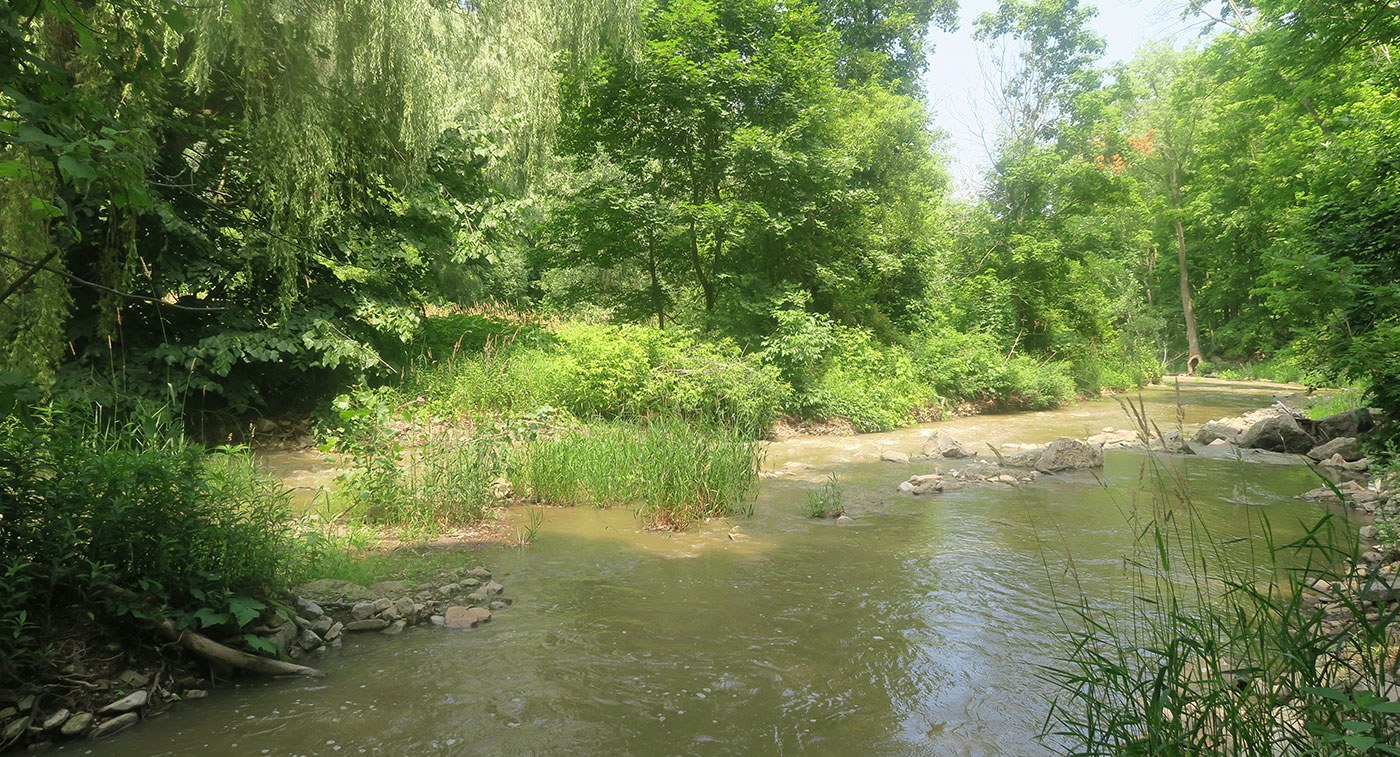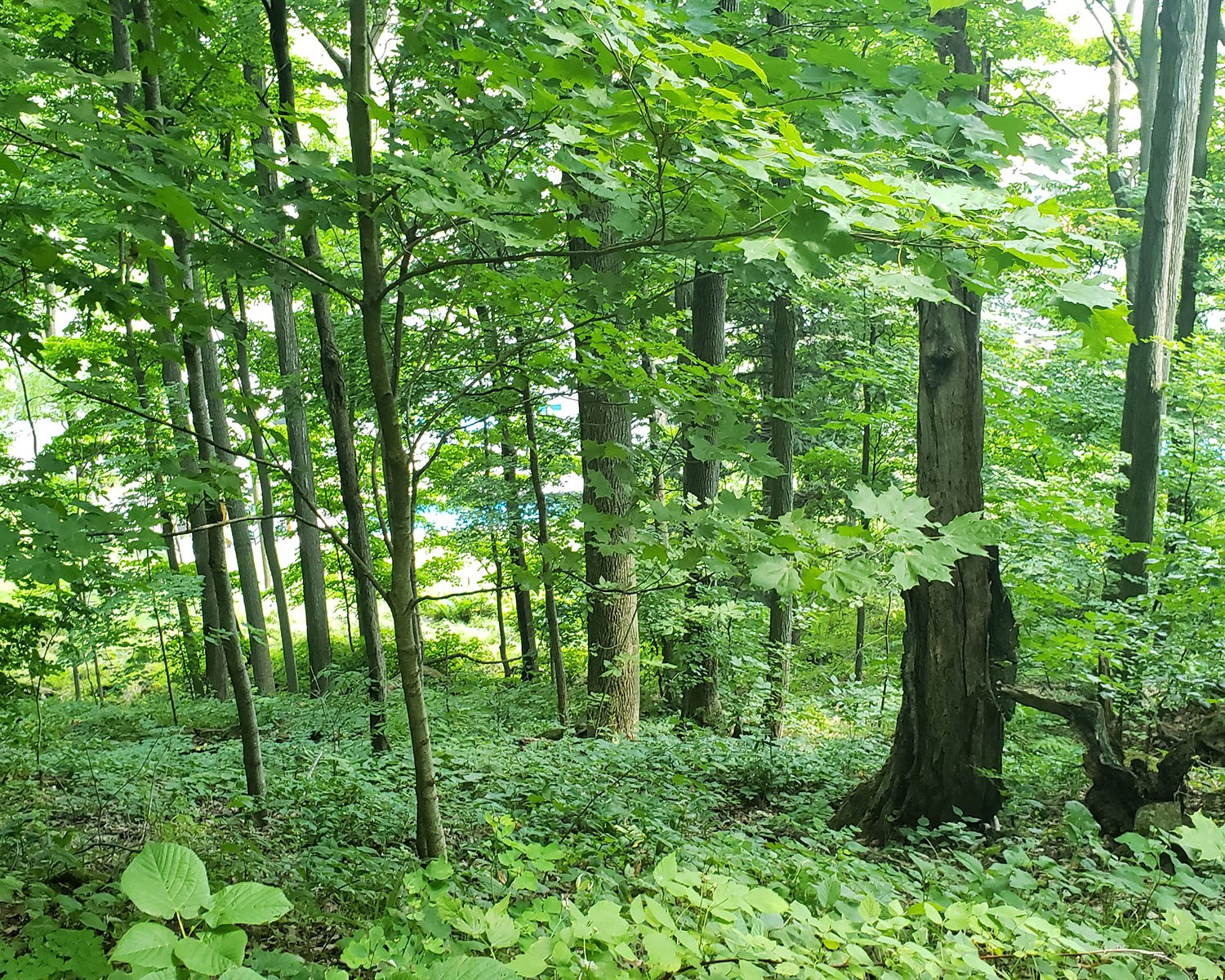Ellis Property
The Ellis Property is located 1 km (0.6 miles) north of Ball’s Falls Conservation Area, just west of the Jordan Historical Museum in the Town of Lincoln. Twenty Mile Creek traverses this 23-hectare (58-acre) property, which contains a variety of escarpment cliff features, two large ponds, diverse Carolinian species, Lake Ontario plain forest and several archaeological sites. The Ellis Property was generously donated to the Ontario Heritage Trust by Art Ellis in 1984.

Publicly accessible?
Yes, a 1-km (0.6-mile) section of trail runs through the Ellis Property from the Twenty-First Street parking lot to the former site of the Jordan Historical Museum. It follows a portion of the Twenty Mile Creek and connects to Jordan’s historical and cultural attractions, including unique shops, trendy cafés, exquisite cuisine and elegant wine shops.
Hours and admissions:
The trail is free and open during daylight hours.
This site is owned by the Ontario Heritage Trust.
Heritage significance
The Ellis Property lies within the Jordan Escarpment Valley, which is a provincially significant Life Science Area of Natural and Scientific Interest (ANSI) within the deep-incised valley of Twenty Mile Creek. This property is also recognized as an Environmentally Significant Area (ESA) and designated as an Escarpment Natural Area under the Niagara Escarpment Plan.
The property is dominated by broadleaf forests with smaller stands of mixed and successional forests. It also contains excellent examples of diverse Carolinian flora and fauna. There are 13 provincially rare, eight regionally rare and 20 locally rare flora species present on the Ellis Property. Rare flora and fauna observed on the property include Nebraska sedge, pignut hickory, eastern spiny softshell turtles, barn owls and many others.
As of 2006, six archaeological sites have been registered: five historical and one Indigenous (Woodland period, 900 BC to AD 1500).

Niagara Twenty Valley Trail Revitalization Project
The Trust is partnering with the Town of Lincoln, the Niagara Peninsula Conservation Authority and the Bruce Trail Conservancy to improve and expand the Niagara Twenty Valley Trail. Thanks to the generous support of the Greenbelt Foundation, phase one of the project was completed in 2022.
The new Twenty Valley Trail network will provide Ontarians improved access to greenspaces and will contribute to local tourism and recreational opportunities in the area.
The current Twenty Valley Trail is a scenic 2-km (1.2-mile) trail that starts in Ball’s Falls Conservation Area and ends at Lake Ontario, connecting with the Waterfront Trail. Once the trail revitalization project is complete, visitors hiking along Twenty Valley Trail will be able to access a continuous 1,366-km trail network (849 miles) that connects Ball’s Falls to the Ontario Heritage Trust’s Ellis property (a natural heritage site recognized as an Environmentally Significant Area), the Bruce Trail and side trails, the main street of Jordan village and the Lincoln Museum and Cultural Centre.
Latest updates
Phase One: Feasibility (complete)
The Trail feasibility study started in March 2022 and was completed in July 2022. It included a tree inventory and various studies (hydrological, geological and ecological) to identify the best route for the new trail network.
Phase Two: Design (complete)
The Trust finished the design of the Twenty Valley Trail in the third quarter of 2023. The trail design follows an optimal route that avoids naturally sensitive areas and maximizes the topography of the property to keep the trail out of flood-prone areas. Archaeological work will also be completed in August 2024.
Phase Three: Construction (in progress)
The Trust has awarded a contract to begin construction on the restoration of the Ellis southern trail, previously known as the Twenty Valley Trail. This project aims to enhance connectivity with the existing trail network at Ellis and the established trails at Ball’s Falls.
The contractor will be constructing a limestone screening trail, which will be protected by a vegetated buttress. Additionally, an armourstone wall will be built adjacent to Twenty Valley Creek to prevent further erosion. Once the site is stabilized, we will restore it with native plantings to enhance the local ecosystem.
Also, as part of our commitment to responsible development, we conducted an Archaeological Stage 2 study in August 2024 that cleared the construction to proceed. Construction is set to begin in November 2024 and is expected to be completed by April 1, 2025.
We look forward to sharing updates as the project progresses!
The Ellis property is situated along the Niagara Escarpment area and is considered part of the greater grouping of natural systems known as the Greenbelt. Ontario’s Greenbelt is one of the most biologically rich areas in all of Canada, and with nearly 810,000 hectares (over two million acres) of farmland, forests, wetlands and rivers, it provides the residents of Ontario with clean air, fresh water and a reliable local food source. The Greenbelt's natural areas provide essential climate resilience for local communities in the Greater Golden Horseshoe — Canada's most rapidly urbanizing region. Greenbelt natural features — like forests, rivers, wetlands and healthy soils — help to prevent flooding, protect our freshwater and offset the urban heat-island effect, helping to keep the air feeling cool during heat waves. Ontario’s Greenbelt provides a home for wildlife and critical species at risk, and ensures that our communities have green space to explore.
The Greenbelt provides accessible greenspace for Ontario's growing population. With one in four Canadians living in the Greater Golden Horseshoe, the Greenbelt is an essential resource for outdoor recreation, safely connecting with friends and loved ones, and exploring nature. Time spent in nature has proven benefits to physical and mental health and the Trust with its partners plan to improve access to these great natural areas with the creation of the Twenty Valley Trail.
Your support is needed!
Help us connect more people to Ontario’s natural spaces and cultural heritage.
